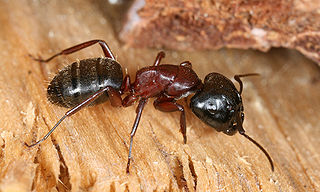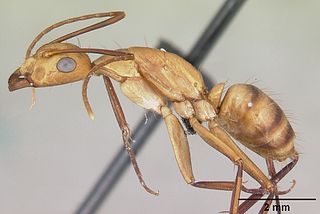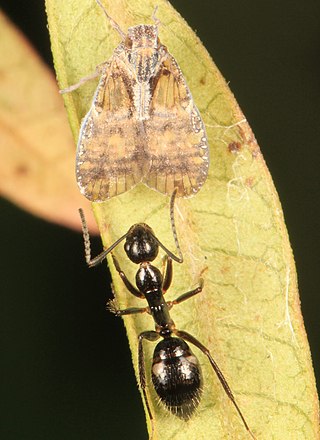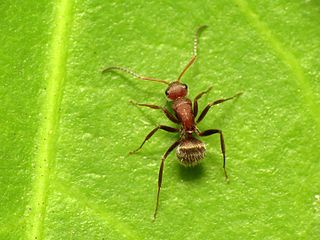
Lasius is a genus of formicine ants. The type species for this genus is the black garden ant, Lasius niger. Other major members, which live in drier heathland, are the cornfield ant, L. neoniger, and L. alienus. Other species include the temporary social parasites of the L. mixtus group and the hyper-social parasite Lasius fuliginosus. Lasius flavus is also a commonly seen species, building grassy hillocks in undisturbed pasture. In the Alps, these mounds – always aligned east to catch the first rays of the rising sun – have been traditionally used by goatherds as natural compasses. Species in the subgenus Acanthomyops, in particular L. interjectus and L. claviger, are commonly known as citronella ants due to their citronella-like smell.

Carpenter ants are large ants indigenous to many forested parts of the world.

Camponotus nearcticus, commonly named smaller carpenter ant, is a relatively small carpenter ant. Its appearance is similar to Lasius niger, commonly named the black garden ant. The ant is a household pest.

Camponotus vagus is a species of large, black, Palaearctic carpenter ant with a wide range that includes much of Europe, a large area of Asia, and part of Africa.

Camponotini is a tribe containing 2 extinct ant genera and 8 extant ant genera, including Camponotus.

Notostigma is a genus of ants in the subfamily Formicinae. Its two species are known only from Australia. Workers are nocturnal and forage solitarily. Notostigma was first described by Emery (1920), when he erected the new genus for three species of carpenter ants (Camponotus).
Camponotus irritans is a species of carpenter ant. It is found in many Asian and Oceanian countries.

Camponotus maculatus is a species of carpenter ant.

Camponotus rufoglaucus is a species of carpenter ant. It is found from many Afrotropical, Indo-Australian, Oriental, Palaearctic regional countries.
Camponotus thraso is a species of carpenter ant. The type species is found from Sri Lanka.

Camponotus variegatus is a species of carpenter ant.

The black-headed sugar ant, also known as the brown sugar ant, is a species of Formicinae ant endemic to Australia. Found throughout most states, the species is a member of the genus Camponotus, a cosmopolitan genus of ants commonly known as carpenter ants. It was formally described and named by British entomologist Frederick Smith in 1858. These ants are characterised by their black head, reddish-brown mesosoma and black gaster, which can change in colour.

Camponotus sexguttatus is a species of carpenter ant native to South America, Central America, Mexico, and the Caribbean. This species is invasive in Florida, Hawaii, and Arizona.

Camponotus planatus, known generally as the compact carpenter ant or short carpenter ant, is one of three Camponotus species that is polygynous, or has more than one queen. It is a species of ant.

Pheidole hyatti is an ant, a species of higher myrmicine in the family Formicidae.

Camponotus pudorosus is a species of carpenter ant native to Arizona, New Mexico, Colorado, Mexico, and Guatemala. Originally described in 1925 by Carlo Emery and synonymized by W. W. Kempf in 1972, the species was revived in 2006 from the Camponotus festinatus complex by Roy Snelling.















